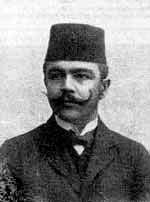Safvet-beg Bašagić
| Safvet-beg Bašagić | |
|---|---|
 | |
| Born |
6 May 1870 Nevesinje, Bosnia Vilayet, Ottoman Empire |
| Died |
9 April 1934 (aged 63) Sarajevo, Drina Banovina, Kingdom of Yugoslavia |
| Pen name | Mirza Safvet |
| Occupation | Writer |
Dr. Safvet-beg Bašagić (6 May 1870 – 9 April 1934), also known as Mirza Safvet, was a Bosnian writer considered the father of Bosnian Renaissance, and one of most cherished poets of Bosnia and Herzegovina at the turn of the 20th century. Bašagić co-founded the political journal Behar and was a founder of the cultural society and magazine Gajret, and was elected President of the Bosnian council in 1910. He is also well known for his lexicon that exceeded seven hundred biographies that he compiled over decades.
Life
A Bosniak, he was born in Nevesinje. His maternal grandfather was Dedaga Čengić, himself the son of agha Smail-aga Čengić (1780–1840). He finished his primary schooling in Konjic, Mostar, and Sarajevo. He received his doctorate at the University of Vienna, where he studied Arabic and Persian languages. Bašagić was installed as the first parliamentary president of the Muslim National organization in 1908.[1] He taught Oriental languages at the University of Zagreb and was an associate of Silvije Strahimir Kranjčević. As president of the Diet of Bosnia, Bašagić advocated either a unification of Bosnia and Herzegovina with Croatia[2] or autonomy[3]. Bašagić was curator of the Archeological Museum in Sarajevo from 1919 to 1927.
Bašagić died in 1934 in Sarajevo and is buried in the harem of Gazi Husrev-beg's Mosque.
Works
The Bašagić collection of Islamic manuscripts and old books, which can be found in the holdings of the University Library in Bratislava, was inscribed on UNESCO's Memory of the World Register in 1997.[4] Part of this collection is available on-line from the World Digital Library.[5]
Bibliography
- Trofanda iz hercegovačke dubrave (1894)
- Kratka uputa u prošlost Bosne i Hercegovine (1463-1850) (1900)
- Abdullah-paša (1900)
- Pod ozijom ili krvava nagrada (1905)
- Misli i čuvstva (1905)
- Gazi Husrev-beg (1907)
- Uzgredne bilješke I (1907)
- Najstariji ferman begova Čengića (1907)
- Bošnjaci i Hercegovci u islamskoj književnosti I (Bosniaks and Herzegovinians in Islamic literature) (1912)
- Izabrane pjesme (1913)
- Opis orijentalnih rukopisa moje biblioteke (1917)
- Nizamul-Alem (translation, 1919)
- Najstarija turska vijest o Kosovkom boju (1924)
- Mevlud (1924)
- Omer Hajjam: Rubaije (translation, 1928)
- Znameniti Hrvati, Bošnjaci i Hercegovci u Turskoj carevini (Illustrious Croats, Bosniaks and Herzegovinians in the Ottoman empire) (1931)
References
- Citations
- ↑ Adil Zulfikarpašić; Milovan Djilas; Nadežda Gaće (1998). The Bosniak. C. Hurst & Co. Publishers. pp. 89–. ISBN 978-1-85065-339-4.
- ↑ Kalamberović 2009, p. 21.
- ↑ Purivatra 1976, p. 18.
- ↑ "Basagic Collection of Islamic Manuscripts". UNESCO Memory of the World Programme. 2008-05-15. Archived from the original on 2013-04-16. Retrieved 2009-12-14.
- ↑ http://www.wdl.org/en/search/gallery?ql=eng&co=380
- Bibliography
- Kamberović, Husnija (2009). Mehmed Spaho (1883-1939): Politička biografija. Vijeće Kongresa bošnjačkih intelektualaca. ISBN 9789958471094.